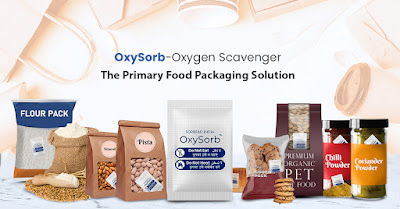Packed food and ready-to-eat food packets are an integral part of modern living that cannot be ignored. Thus, the shelf life of this packed food becomes a critical aspect of the food-related industry. This shelf life indicates a duration when the product can be stored and consumed. During this duration, the product’s quality, nutritional value, and safety are all within check. So that products remain fresh, it is important that their shelf life is extended as otherwise there is more chance of waste or that the product does not meet the regulatory requirement or may not meet the customer’s expectations. Towards this end, one commonly used solution is through the use of oxygen absorbers. They play a significant role in the preservation of the quality as well as the integrity of packed food products and food packaging.
An oxygen absorber for packed food is quite simple in design. They are small packets that contain a mix of iron powder, activated carbon, and sodium chloride (salt). They are designed to remove oxygen from the environment when they are placed in a sealed container or packet. These O2 packets follow a chemical process where the oxygen absorbers remove oxygen and this is known as oxidation. The iron powder that is within the oxygen absorber will react with the oxygen that is in the air and this forms iron oxide or rust which is a by-product. This reaction takes place due to the effect of moisture and so moisture-absorbing materials are packed with the oxygen absorber for packed food. Though the oxidation process produces heat i.e. it's exothermic, the heat is minimal and so the packaging material does not ignite, and neither does the food packaging affect the food product.
O2 packets are available in various sizes and types on the basis of the appreciation and also the volume of the oxygen that has to be absorbed. Oxygen absorbers for packed food are usually iron-based and work well for the packaging of general food. However, when it comes to food or pharmaceuticals, there are specialized absorbers that are required. The sizes too vary from small sachets to larger packets that can be used for bulk storage containers. Therefore it is essential that the right size and type is selected on the basis of the specific requirements and how much optimal oxygen removal is required in order to prolong the product’s shelf-life.
Benefits of Using Oxygen Absorbers in Packed Foods
Oxygen absorbers for packed food provide many benefits. At the most basic level, they extend the shelf life since they remove oxygen from the packaging since oxygen is the main factor that causes the deterioration of food. This is the oxidation reaction that leads to spoilage. When the levels of oxygen are reduced the oxygen inhibitors inhibit the growth of microorganisms as well as delay the degradation process of oils and fats. Furthermore, the oxidation of flavours, colours, and vitamins is prevented as well. Thus, the freshness of the food product as its quality is extended.
The presence of oxygen affects the sensory and quality attributes of packed foods. Through oxygen absorbers, the oxidation of fats is prevented and thus, the freshness, flavour, and texture are preserved. Since the taste, appearance, and aroma are retained customers would be satisfied. Oxygen absorbers for packed food contribute towards food safety as they prevent bacteria and microorganisms from spoiling the food. Due to the reduction of oxygen, the environment is made unfavourable for the survival or growth of these microorganisms and so chances of contamination or food-borne illness are reduced.

Since the shelf-life is preserved as is the freshness and quality of the food, food waste is minimized due to oxygen absorbers. When products have an extended shelf-life they would not spoil or deteriorate prematurely. Thus, food waste is reduced as less food needs to be discarded. Thus, this is not only cost-effective but environmentally sustainable. Furthermore, oxygen absorbers for packed food are versatile and can be used in many types of ready-to-eat packets for snacks, baked foods, processed meat, dry goods, etc. Also, these are adaptable to various types of food packaging like bottles, cans, and pouches as versatile solutions for various food packaging applications.
Food packaging is the only place where oxygen absorbers are used. Though they are primarily used in food packaging there are other industries too which benefit from their use. In the food industry, they work towards the preservation of the flavour, nutritional value, and overall quality of the food. This includes baked goods, dried fruits, snacks, processed meats, and spices in which these oxygen absorbers are used for packed food. Nutraceuticals and pharmaceuticals are oxygen-sensitive and thus, oxygen absorbers prevent the degradation of these products due to oxidation of their active ingredients and this ensures the continued efficacy and potency of the products.
There are also medical devices that are oxygen-sensitive like test strips, pharmaceutical packaging as well as diagnostic kits. Oxygen absorbers help in maintaining their integrity as well as their stability. Thus, the application of oxygen absorbers is primarily used where a controlled environment is required and oxygen needs to be removed. The quantity of oxygen absorbers would depend on the volume as well as the type of food packing and the food product whether they are dry goods like pasta, grains, etc, snacks, or meat products, the quantity would change accordingly.
Thus, oxygen absorbers have varied uses in packed food products from the extension of their shelf-life to improved quality, reduced food waste, and an enhancement of safety. By minimizing the presence of oxygen the absorbers help to preserve the nutritional value, freshness, and taste of the products so that customers are satisfied with the product’s quality.

